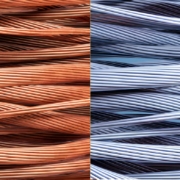Aluminium vs Copper Cables: Safety and Efficiency Guide
In the world of electrical wiring, the debate between aluminium and copper cables continues to be highly relevant, especially in residential, commercial, and industrial applications. Choosing the right type of cable is essential for safety, efficiency, durability, and cost-effectiveness. Understanding the distinct characteristics of aluminium and copper helps in making a well-informed decision for your wiring needs.
When it comes to Aluminium vs Copper Cable, many factors come into play—such as conductivity, weight, installation challenges, corrosion resistance, and, most importantly, safety. In this guide, we’ll compare both types of cables from various practical perspectives to help you choose the right material based on your application.
1. Electrical Conductivity
Copper has long been considered the gold standard for electrical conductivity. It conducts electricity better than aluminium, which means less power loss and higher efficiency. Copper cables can carry more current than aluminium cables of the same size, making them more suitable for high-performance requirements.
Aluminium, on the other hand, has about 61% of the conductivity of copper but is still widely used due to its lightweight nature and lower cost. However, this lower conductivity means that aluminium cables need to be larger in diameter to match the performance of copper cables.
2. Weight and Flexibility
One of the key advantages of aluminium is its light weight. Aluminium cables weigh almost half as much as copper cables, making them easier to handle, transport, and install—especially in overhead power distribution systems.
Copper, being heavier and denser, can be more challenging to work with in large-scale installations. However, its flexibility and durability often offset these drawbacks in indoor or compact installations.
3. Cost Efficiency
In terms of raw material cost, aluminium is significantly cheaper than copper. This cost difference becomes critical in large-scale infrastructure projects where long distances of wiring are needed. This affordability has made aluminium cables increasingly popular in utility grids and large construction projects.
Despite the higher cost, copper cables offer better longevity and less maintenance over time, which can lead to lower long-term operational costs.
4. Thermal Expansion and Heat Resistance
Aluminium expands and contracts more with temperature changes than copper. This thermal expansion can loosen connections over time, leading to overheating and increased risk of fire if not properly maintained. As a result, aluminium wiring installations require careful attention to connection techniques and often need special terminals or connectors.
Copper’s lower thermal expansion makes it more stable under changing temperatures, reducing the risk of loose connections and improving safety in the long run.
5. Corrosion Resistance and Durability
Both materials have their pros and cons in terms of corrosion resistance. Aluminium naturally forms an oxide layer when exposed to air, which helps prevent further corrosion. However, in damp or chemically aggressive environments, this oxide can degrade, leading to potential conductivity issues.
Copper, on the other hand, is more resistant to environmental degradation and maintains stable conductivity over time. It’s also less likely to experience galvanic corrosion when used alongside other metals.
6. Safety Considerations
Safety is one of the most important considerations in the Aluminium vs Copper Cable debate. Historically, aluminium wiring gained a bad reputation in the 1960s and 1970s due to a spate of electrical fires caused by faulty installation and poor-quality connectors.
However, modern aluminium cables have improved considerably in design and safety when used with the correct fittings and maintenance. Copper remains the safer choice in most applications due to its lower resistance, better conductivity, and reduced thermal expansion.
7. Application-Specific Recommendations
Here’s a quick comparison for different types of electrical projects:
| Application Type | Recommended Cable Type | Reason |
|---|---|---|
| Residential Wiring | Copper | Higher safety and conductivity |
| Overhead Power Distribution | Aluminium | Lightweight and cost-effective |
| Underground Cabling | Copper | Durability and corrosion resistance |
| Industrial Plants | Copper (Indoor) / Aluminium (Outdoor) | Performance vs. cost trade-off |
| Temporary Installations | Aluminium | Budget-friendly and easy to install |
8. Installation and Maintenance
Installing aluminium cables requires more caution. The installer must use anti-oxidizing compounds, compatible connectors, and ensure secure tightening to avoid fire hazards or voltage drops. Regular inspections are also necessary to prevent issues caused by expansion and contraction.
Copper cables are easier to work with, require less maintenance, and are more forgiving in high-demand or fluctuating load scenarios. This ease of use often makes copper the first choice for many electricians and engineers.
9. Environmental Impact
From an environmental standpoint, aluminium is more abundant and easier to extract than copper. However, the extraction and processing of aluminium are more energy-intensive. Copper mining, on the other hand, can be more harmful to ecosystems due to chemical leaching.
Both materials are recyclable, and recycling plays a significant role in reducing their carbon footprint. Recycled copper retains 90–100% of its original conductivity, making it highly sustainable.
10. Final Verdict: Which Should You Choose?
Choosing between Aluminium vs Copper Cable ultimately depends on the nature of your project, budget, and safety requirements. Here’s a summary:
- Choose Copper Cables if safety, high conductivity, and long-term durability are your priorities.
- Opt for Aluminium Cables if budget constraints, weight reduction, and large-scale deployment are critical factors.
Modern aluminium cables have become much safer and more efficient, but copper still holds the edge in reliability and performance, particularly for indoor wiring and high-demand applications.
Conclusion
Both aluminium and copper cables have unique strengths and limitations. Understanding these characteristics enables informed decisions that balance cost, performance, and safety. Whether you’re an electrical contractor, an engineer, or a homeowner, choosing the right cable type is crucial to ensuring long-lasting, efficient, and safe electrical systems.
Always consult with certified electrical professionals when making final decisions on material types, especially for large or high-risk installations.

